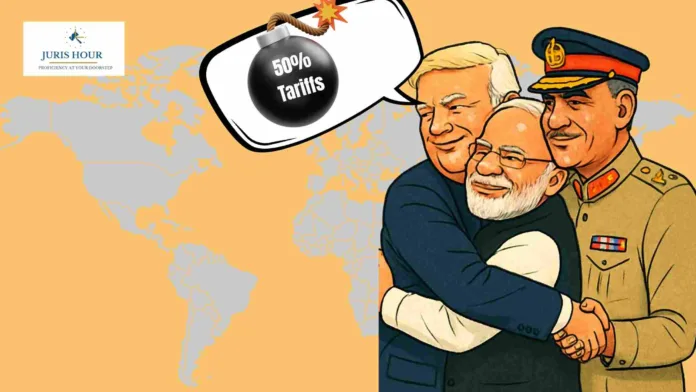The United States has imposed a steep 50% tariff on Indian goods over its continued import of Russian oil, marking a dramatic escalation in trade tensions and sending shockwaves through an already strained relationship between the two countries.
The unexpected move, announced on Wednesday, includes a fresh 25 percent tariff increase atop an existing levy, and is set to come into effect within three weeks. This places India alongside Brazil as the only nations facing such a high tariff wall from the US under President Donald Trump’s administration.
Despite public bonhomie between Trump and Indian Prime Minister Narendra Modi — who have often referred to each other as friends — this aggressive trade measure highlights the US’s pivot away from so-called “friend-shoring” policies. Experts say the tariffs are part of a broader push by Trump to bring manufacturing back to American soil, even at the expense of long-standing partnerships.
“This is arguably the lowest point in US-India ties in years,” said Vina Nadjibulla, Vice President of Strategy and Research at the Asia Pacific Foundation of Canada. “The breakdown of trade talks was surprising and has now left India with the highest tariff rate and no deal in hand.”
Flashpoints Behind the Fallout
The tariffs follow weeks of growing tension, with Trump warning of penalties for New Delhi’s continued energy and defense ties with Russia. In a recent outburst, Trump referred to both India and Russia as “dead economies” and expressed frustration over stalled trade negotiations.
Last year, bilateral trade between the two countries hit $212 billion, with India enjoying a surplus of about $46 billion. Prime Minister Modi had previously aimed to double trade to $500 billion in five years, but the latest developments could throw that ambition into jeopardy.
According to reports, India had offered several concessions to avoid trade penalties, including lowering tariffs on US industrial goods, scaling back levies on imported cars, and increasing defense and energy purchases. However, New Delhi remained firm in protecting its farm and dairy sectors—industries that employ hundreds of millions and are politically sensitive.
Geopolitics and Perceptions
Farwa Aamer, Director of South Asia Initiatives at the Asia Society Policy Institute, pointed out that underlying geopolitical tensions have also played a role. A major point of friction has been the US claim that Trump mediated a ceasefire between India and Pakistan during their May conflict—an assertion firmly denied by New Delhi.
Meanwhile, Pakistan has publicly supported Trump’s version of events, even suggesting him for a Nobel Peace Prize. The US has also signed new mineral and energy deals with Pakistan, signaling a potential shift in Washington’s South Asia policy.
“This is a serious foreign policy test for India,” said Aamer. “The challenge now is whether India can maintain its long-standing ties with Russia while navigating a rocky road with the US.”
India has dismissed the new tariffs as “unfair, unjustified, and unreasonable,” reiterating that its imports of Russian oil are driven by its national energy needs for a population of over 1.4 billion.
Business Confidence Shaken
The tariffs come at a critical juncture for India’s economic aspirations. As global manufacturers seek alternatives to China, India has been aggressively marketing itself as a new global supply chain hub. Apple, for example, announced plans in April to assemble all US-bound iPhones in India by 2026.
But experts warn that branding India with the highest tariff tag could deter investment. “This just adds to the uncertainty for businesses already rattled by Trump’s trade policies,” said Nadjibulla. “He’s shown he’s more interested in onshoring than rewarding allies.”
Looking Ahead
Despite the setback, experts believe both nations may engage in “creative diplomacy” to reset the relationship. Robert Rogowsky, professor of international trade at the Middlebury Institute, said the high-stakes standoff could spur a new round of negotiations.
“Strong-arming a leader like Modi can create unintended consequences,” he said. “But it also opens the door for serious diplomatic recalibration.”
India, meanwhile, is expected to double down on alternate trade partnerships. A recent deal with the UK and ongoing talks with the European Union signal that New Delhi is looking to hedge its bets amid shifting global alliances.
Modi is also expected to travel to China later this month to attend the Shanghai Cooperation Organisation summit — his first visit since the Galwan border clash in 2020 — as part of a broader strategy to rebalance India’s diplomatic ties.
As both nations weigh their next moves, one thing is clear: the Trump-Modi relationship, once hailed as a symbol of new-age diplomacy, now faces its biggest stress test yet.
Read More: Chief Commissioner S.K. Rahman Hands Over Rs. 23 Lakh Cheque to Support Wayanad Landslide Survivors

